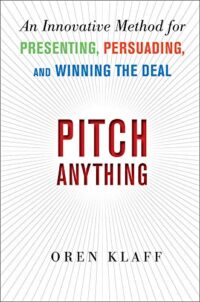
Reading Notes for:
Pitch Anything
By Oren Klaff
An Innovative Method for Presenting, Persuading, and Winning the Deal
The Big Idea can be explained in 1 minute. The beginning is not the time for details. Too many details up-front will make the pitch go stale. Introduce later with the Idea Introduction Pattern:
For target clients who are dissatisfied with the options in the marketplace, my idea/product is a new kind of product category. It provides THESE key solutions to THESE key problems. Unlike competing products, we have THESE important features.
“For building owners in California and AZ, that are dissatisfied with their aging solar technology, our product allows for a plug-and-play upgrade. Without equipment replacement, we can increase production of existing solar panel by 30%”
Designed to capture their attention without threat. Including social threats like looking stupid or failing. Adrenaline kicks in and we have anxiety. And they can pick up on your anxiety, which will give them anxiety.
Phase 1: You put the target at ease by telling them that the pitch will be short and you won’t be hanging out
- Then you give a brief background of successes. But the more you talk about your successes, the more likely they are to average it out.
- Next, show that your idea is not a static stroke of genius. It’s a market window that is open and needs to be capitalized on. Paint the picture of the idea moving out of the old market and into the new one.
- Last, you bring the idea into play using the Idea Introduction Pattern.
Phase 2: Explain the budget and the secret sauce. Gets harder to hold their attention. Have to explain what problems the idea really solves and how it works. There will be many opportunities to freak out the croc brain here. Urge is to keep it simple. However simplicity can make you seem naïve and stupid. You have to tune the message to the mind of the target.
The Working Theory of Mind: you understand how the thoughts, theories, and intentions of others cause them to act. When somebody can only see a situation 1 way, their Theory of Mind is weak or inoperative. When you have a strong one, you can see that others have different ideas and perspectives. They are not always the same as yours.
Probabilities need to be simplified because it freaks out the Croc brain. Can explain complex human relationships though. It can understand that.
2 big realizations:
1. It doesn’t matter how much information that you give, it just matters how strong your Theory of Mind is. How well you can tune your information to the other person’s mind.
2. All of the important stuff must fit into the audience’s attention span. Which for most people is about 20 minutes.
The most common thing to go wrong is your pitch is boring. Attention waivers uncontrollably. Attention will be high when information novelty is high. And with no visual stimulus.
People enjoy some intermediate level of intellectual complexity. Which is why people like mysteries. People are curious about things that cannot seem to explain, however are explainable. * Why novelty and curiosity are important.
What is attention made of? A cocktail of chemicals served up to the brain. When a person is feeling both desire and tension they are paying serious attention to what is in front of them. It’s a balancing act of desire and tension. Releases dopamine (desire) and norepinephrine (tension). Balancing will give you about 20 minutes of attention to make a point.
To create a dopamine kick, you have to offer a reward. Levels raise when you see or hear something that you want. Also caffeine, Yohimbe root, cocaine, and Sudafed. Also thought of winning a gamble or winning a status item (rolex). Connected to things like food, sex, and drugs.
Not the chemical of experiencing pleasure. The chemical of anticipating pleasure.
Novelty is highly effective at releasing dopamine.
Charisma is a weak form of novelty.
Create novelty by violating their expectations in a pleasing way. New idea and new concepts. Familiar stuff in new colors, shapes, and configurations provide novelty. Unexpected gain causes a blast of dopamine.
Dopamine tells the body to act on some things and ignore others. Create curiosity about your big idea.
Be warned that novelty has the potential to trigger retreat or exploration. Curiosity is the difference.
However, if the dopamine is expecting a reward – and it doesn’t come – the dopamine drop is fast and bad.
To create a norepinephrine kick, you have to take something away. The chemical of alertness. Tension is the introduction of some real consequences of a social encounter. The realization that something will be gained or lost. There is no reason to pay attention if there are no stakes. Consequence = importance in the brain.
Pay attention to the interplay of pushing the target away and pulling them toward us. Keeps target alert.
